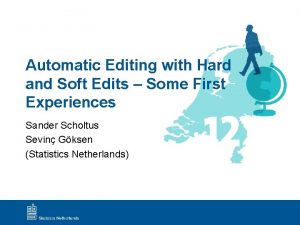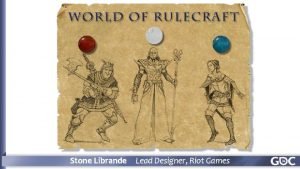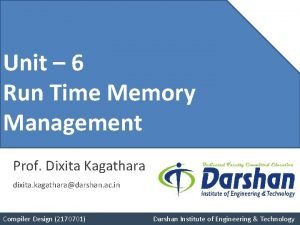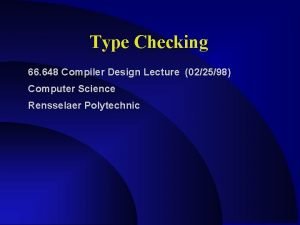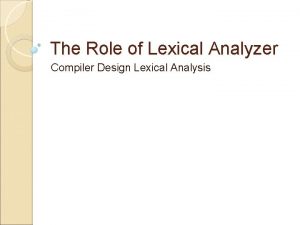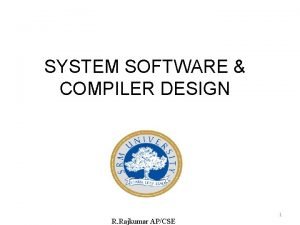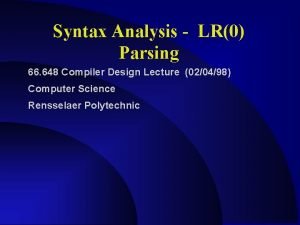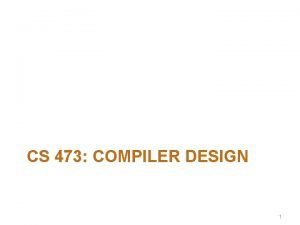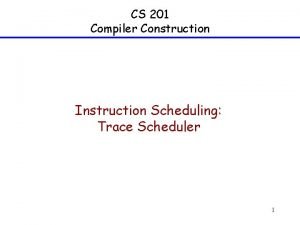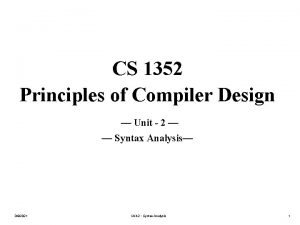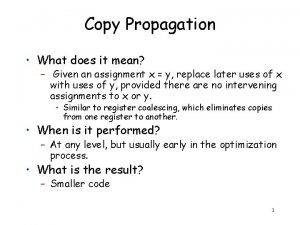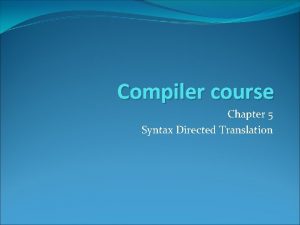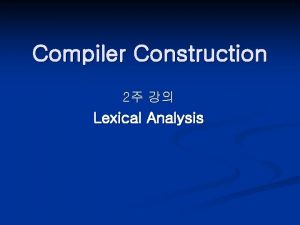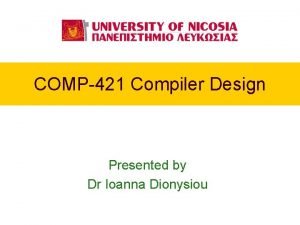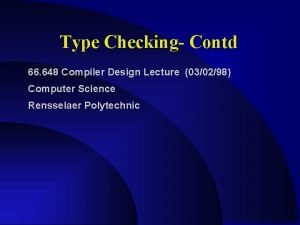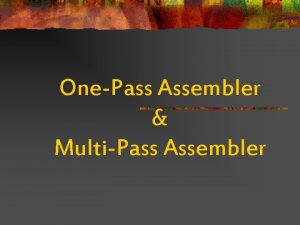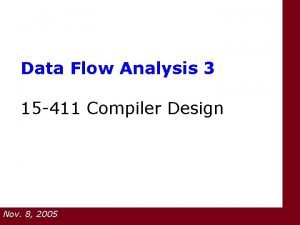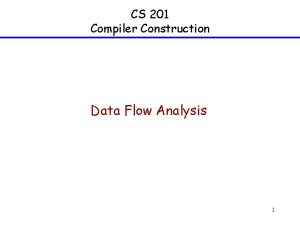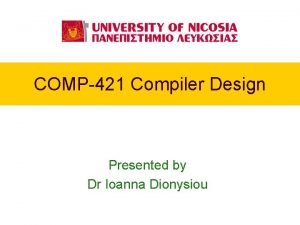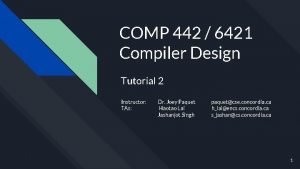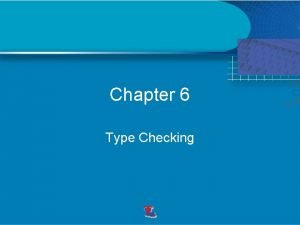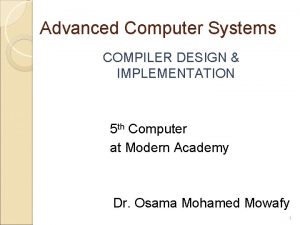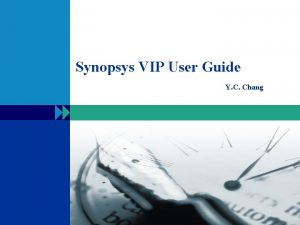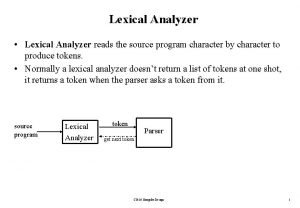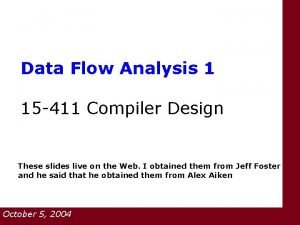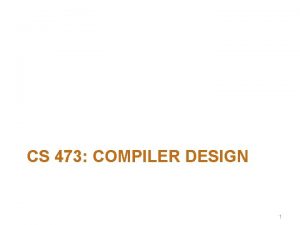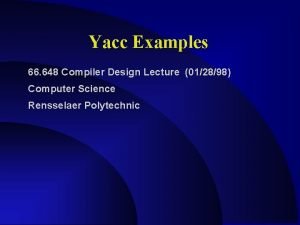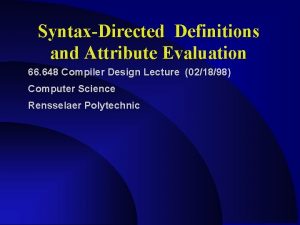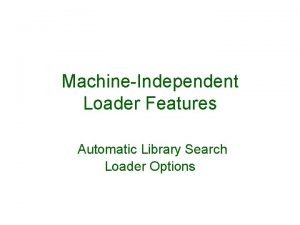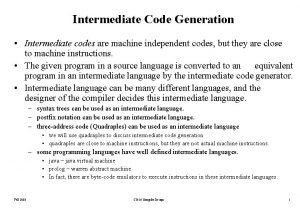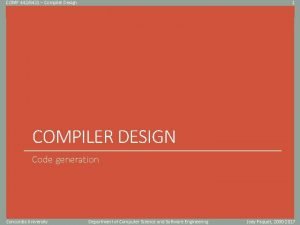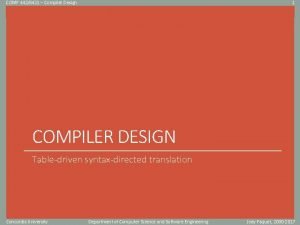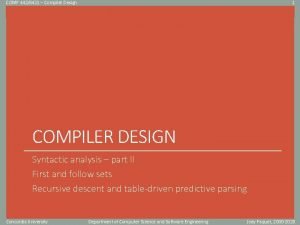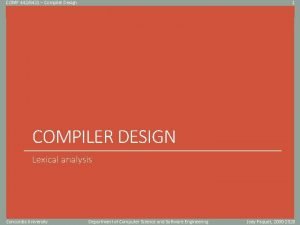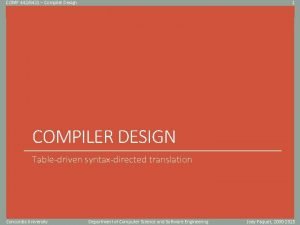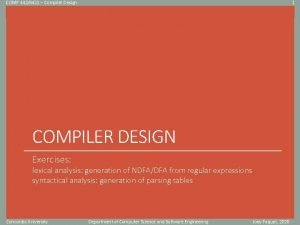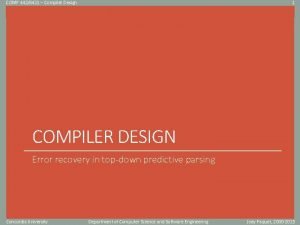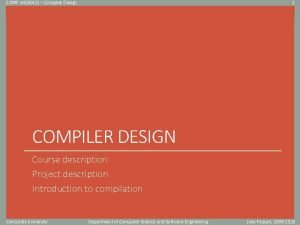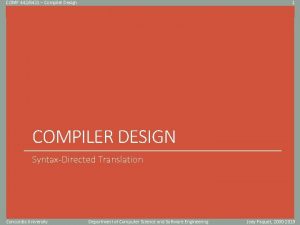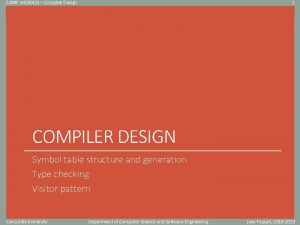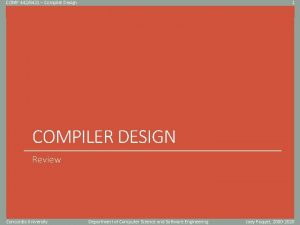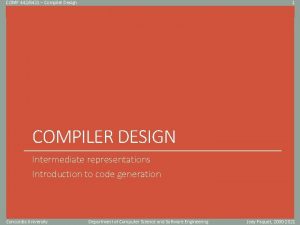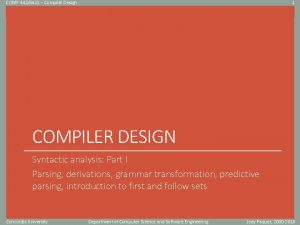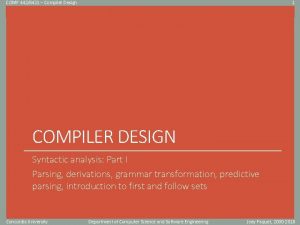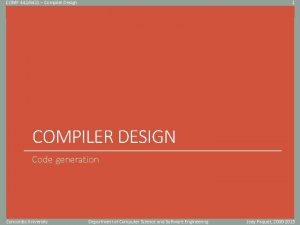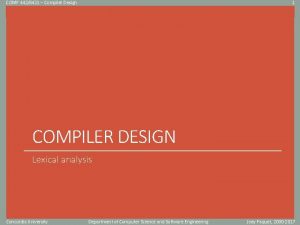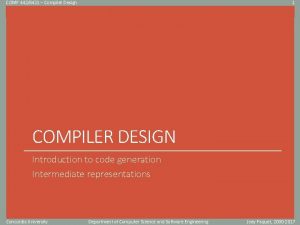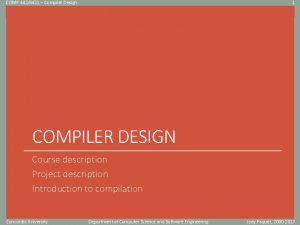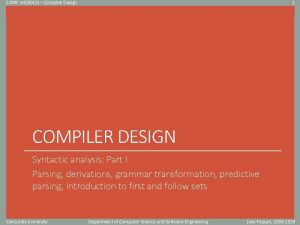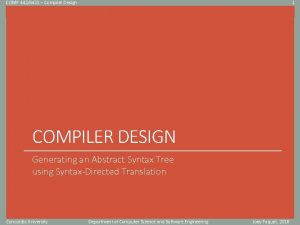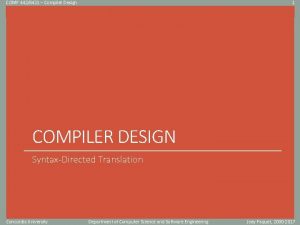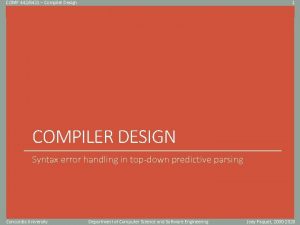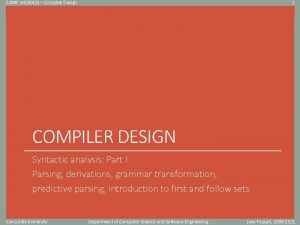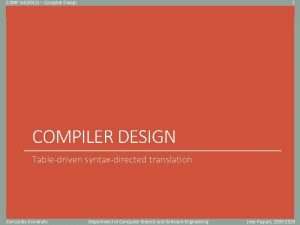COMP 4426421 Compiler Design 1 Click to edit











































- Slides: 43

COMP 442/6421 – Compiler Design 1 Click to edit Master title style COMPILER DESIGN Lexical analysis Concordia University Department of Computer Science and Software Engineering Joey Paquet, 2000 -2019

COMP 442/6421 – Compiler Design 2 Lexical analysis • Lexical analysis is the process of converting a sequence of characters into a sequence of tokens. • A program or function which performs lexical analysis is called a lexical analyzer , lexer or scanner. • A scanner often exists as a single function which is called by the parser, whose • • functionality is to extract the next token from the source code. The lexical specification of a programming language is defined by a set of rules which defines the scanner, which are understood by a lexical analyzer generator such as lex or flex. These are most often expressed as regular expressions. The lexical analyzer (either generated automatically by a tool like lex, or handcrafted) reads the source code as a stream of characters, identifies the lexemes in the stream, categorizes them into tokens, and outputs a token stream. This is called "tokenizing. " If the scanner finds an invalid token, it will report a lexical error. Concordia University Department of Computer Science and Software Engineering Joey Paquet, 2000 -2019

COMP 442/6421 – Compiler Design 3 Roles of the scanner • Removal of comments • Comments are not part of the program’s meaning • Multiple-line comments? • Nested comments? • Case conversion • Is the lexical definition case sensitive? • For identifiers • For keywords Concordia University Department of Computer Science and Software Engineering Joey Paquet, 2000 -2019

COMP 442/6421 – Compiler Design 4 Roles of the scanner • Removal of white spaces • Blanks, tabulars, carriage returns • Is it possible to identify tokens in a program without spaces? • Interpretation of compiler directives • #include, #ifdef, #ifndef and #define are directives to “redirect the input” of the compiler • May be done by a pre-compiler • Initial creation of the symbol table • A symbol table entry is created when an identifier is encountered • The lexical analyzer cannot create the whole entries • Can convert literals to their value and assign a type • Convert the input file to a token stream • Input file is a character stream • Lexical specifications: literals, operators, keywords, punctuation Concordia University Department of Computer Science and Software Engineering Joey Paquet, 2000 -2019

COMP 442/6421 – Compiler Design 5 Lexical specifications: tokens and lexemes • Token: An element of the lexical definition of the language. • Lexeme: A sequence of characters identified as a token. Concordia University Token Lexeme id distance, rate, time, a, x relop >=, <, == openpar ( if if then assignop = semi ; Department of Computer Science and Software Engineering Joey Paquet, 2000 -2019

COMP 442/6421 – Compiler Design 6 Click to edit Master title style Design of a lexical analyzer Concordia University Department of Computer Science and Software Engineering Joey Paquet, 2000 -2019

COMP 442/6421 – Compiler Design 7 Design of a lexical analyser • Procedure 1. 2. 3. 4. 5. 6. Construct a set of regular expressions (REs) that define the form of any valid token Derive an NDFA from the REs Derive a DFA from the NDFA Translate the NDFA to a state transition table Implement the algorithm to interpret the table • This is exactly the procedure that a scanner generator is implementing. • Scanner generators include: • Lex, flex • Jlex • Alex • Lexgen • re 2 c Concordia University Department of Computer Science and Software Engineering Joey Paquet, 2000 -2019

COMP 442/6421 – Compiler Design 8 Regular expressions s a r | s s* s+ : : : { } {s | s in s^} {a} {r | r in r^} or {s | s in s^} {sn | s in s^ and n>=0} {sn | s in s^ and n>=1} id : : = letter(letter|digit)* Concordia University Department of Computer Science and Software Engineering Joey Paquet, 2000 -2019

COMP 442/6421 – Compiler Design 9 Deriving DFA from REs • Thompson’s construction is an algorithm invented by Ken Thompson in 1968 to translate regular expressions into an NFA. • Rabin-Scott powerset construction is an algorithm invented by Michael O. Rabin and Dana Scott in 1959 to transform an NFA to a DFA. • Kleene’s algorithm, is an algorithm invented by Stephen Cole Kleene in 1956 to transform a DFA into a regular expression. • These algorithms are the basis of the implementation of all scanner generators. Ken Thompson Dana Scott Michael O. Rabin Concordia University Department of Computer Science and Software Engineering Stephen Cole Kleene Joey Paquet, 2000 -2019

COMP 442/6421 – Compiler Design 10 Click to edit Master title style Thompson’s construction Concordia University Department of Computer Science and Software Engineering Joey Paquet, 2000 -2019

COMP 442/6421 – Compiler Design 11 REs to NDFA: Thompson’s construction id : : = letter(letter|digit)* Concordia University Department of Computer Science and Software Engineering Joey Paquet, 2000 -2019

COMP 442/6421 – Compiler Design 12 Thompson’s construction • Thompson’s construction works recursively by splitting an expression into its constituent subexpressions. • Each subexpression corresponds to a subgraph. • Each subgraph is then grafted with other subgraphs depending on the nature of the composed subexpression, i. e. • An atomic lexical symbol • A concatenation expression • A union expression • A Kleene star expression Concordia University Department of Computer Science and Software Engineering Joey Paquet, 2000 -2019

COMP 442/6421 – Compiler Design 13 Thompson’s construction: example (a|b)*abb Concordia University Department of Computer Science and Software Engineering Joey Paquet, 2000 -2019

COMP 442/6421 – Compiler Design 14 Thompson’s construction: example (a|b)*abb Concordia University Department of Computer Science and Software Engineering Joey Paquet, 2000 -2019

COMP 442/6421 – Compiler Design 15 Thompson’s construction: example (a|b)*abb Concordia University Department of Computer Science and Software Engineering Joey Paquet, 2000 -2019

COMP 442/6421 – Compiler Design 16 Click to edit Master title style Rabin-Scott powerset construction Concordia University Department of Computer Science and Software Engineering Joey Paquet, 2000 -2019

COMP 442/6421 – Compiler Design 17 Rabin-Scott powerset construction: concepts • SDFA: set of states in the DFA • SNFA: set of states in the NFA • Σ: set of all symbols in the lexical specification. • ɛ-closure(S): set of states in the NDFA that can be reached with ɛ transitions from any element of the set of states S, including the state itself. • Move. NFA(T, a): state in SNFA to which there is a transition from one of the states in states set T, having encountered symbol a. • Move. DFA(T, a): state in SDFA to which there is a transition from one of the states in states set T, having encountered symbol a. id : : = letter(letter|digit)* Concordia University Department of Computer Science and Software Engineering Joey Paquet, 2000 -2019

COMP 442/6421 – Compiler Design 18 Rabin-Scott powerset construction: algorithm Concordia University Department of Computer Science and Software Engineering Joey Paquet, 2000 -2019

COMP 442/6421 – Compiler Design 19 Rabin-Scott powerset construction: example Concordia University Department of Computer Science and Software Engineering Joey Paquet, 2000 -2019

COMP 442/6421 – Compiler Design 20 Rabin-Scott powerset construction: example Starting state A = ɛ-closure(0) = {0} State A : {0} move. DFA(A, l) = ɛ-closure(move. NFA(A, l)) = ɛ-closure({1}) = {1, 2, 4, 7} = B {1, 2, 4, 7} move. DFA(A, d) = ɛ-closure(move. NFA(A, d)) = ɛ-closure({}) = {} Concordia University Department of Computer Science and Software Engineering Joey Paquet, 2000 -2019

COMP 442/6421 – Compiler Design 21 Rabin-Scott powerset construction: example State B : {1, 2, 4, 7} move. DFA(B, l) = ɛ-closure(move. NFA(B, l)) = ɛ-closure({3}) = {1, 2, 3, 4, 6, 7} = C {1, 2, 3, 4, 6, 7} move. DFA(B, d) = ɛ-closure(move. NFA(B, d)) = ɛ-closure({5}) = {1, 2, 4, 5, 6, 7} = D {1, 2, 4, 5, 6, 7} Concordia University Department of Computer Science and Software Engineering Joey Paquet, 2000 -2019

COMP 442/6421 – Compiler Design 22 Rabin-Scott powerset construction: example State C : {1, 2, 3, 4, 6, 7} move. DFA(C, l) = ɛ-closure(move. NFA(C, l)) = ɛ-closure({3}) = {1, 2, 3, 4, 6, 7} = C {1, 2, 3, 4, 6, 7} move. DFA(C, d) = ɛ-closure(move. NFA(C, d)) = ɛ-closure({5}) = {1, 2, 4, 5, 6, 7} = D {1, 2, 4, 5, 6, 7} Concordia University Department of Computer Science and Software Engineering Joey Paquet, 2000 -2019

COMP 442/6421 – Compiler Design 23 Rabin-Scott powerset construction: example State D : {1, 2, 4, 5, 6, 7} {1, 2, 3, 4, 6, 7} move. DFA(D, l) = ɛ-closure(move. NFA(D, l)) = ɛ-closure({3}) = {1, 2, 3, 4, 6, 7} = C move. DFA(D, d) = ɛ-closure(move. NFA(D, d)) = ɛ-closure({5}) = {1, 2, 4, 5, 6, 7} = D {1, 2, 4, 5, 6, 7} Concordia University Department of Computer Science and Software Engineering Joey Paquet, 2000 -2019

COMP 442/6421 – Compiler Design 24 Rabin-Scott powerset construction: example Final states: {1, 2, 3, 4, 6, 7} {0} {1, 2, 4, 7} {1, 2, 4, 5, 6, 7} Concordia University Department of Computer Science and Software Engineering Joey Paquet, 2000 -2019

COMP 442/6421 – Compiler Design 25 Generate state transition table Concordia University state letter digit final A B B C D Y C C D Y D C D Y N Department of Computer Science and Software Engineering Joey Paquet, 2000 -2019

COMP 442/6421 – Compiler Design 26 Click to edit Master title style Implementation Concordia University Department of Computer Science and Software Engineering Joey Paquet, 2000 -2019

COMP 442/6421 – Compiler Design 27 Implementation concerns • Backtracking • Principle : A token is normally recognized only when the next character is read. • Problem : Maybe this character is part of the next token. • Example : x<1 “<“ is recognized only when “ 1” is read. In this case, we have to backtrack one character to continue token recognition without skipping the first character of the next token. • Solution : include the occurrence of these cases in the state transition table. • Ambiguity • Problem : Some tokens’ lexemes are subsets of other tokens. • Example : • n-1. Is it <n><-><1> or <n><-1>? • Solutions : • Postpone the decision to the syntactic analyzer • Do not allow sign prefix to numbers in the lexical specification • Interact with the syntactic analyzer to find a solution. (Induces coupling) Concordia University Department of Computer Science and Software Engineering Joey Paquet, 2000 -2019

COMP 442/6421 – Compiler Design 28 Example • Alphabet : • {: , *, =, (, ), <, >, {, }, [a. . z], [0. . 9]} • Simple tokens : • {(, ), : , <, >} • Composite tokens : • {: =, >=, <>, (*, *)} • Words : • id : : = letter(letter | digit)* • num : : = digit* • {…} or (*…*) represent comments Concordia University Department of Computer Science and Software Engineering Joey Paquet, 2000 -2019

COMP 442/6421 – Compiler Design 29 Example • Ambiguity problems character possible tokens : : , : = > >, >= < <, <=, <> ( (, (* * *, *) • Solution: Backtracking • Must back up a character when we read a character that is part of the next token. • Each case is encoded in the table Concordia University Department of Computer Science and Software Engineering Joey Paquet, 2000 -2019

COMP 442/6421 – Compiler Design 30 Example - DFA ID NUM CMT ERR OPENPAR CMT COLON ASSGN LT LESSEQ NOTEQ GT GREATEQ CLOSEPAR Concordia University Department of Computer Science and Software Engineering Joey Paquet, 2000 -2019

COMP 442/6421 – Compiler Design 31 Table-driven scanner – state transition table l d { } ( * ) : = < > sp 1 2 4 6 20 8 20 20 13 20 15 18 1 2 2 2 3 3 3 1 1 1 4 5 5 5 1 1 1 6 6 7 6 6 6 6 7 1 1 1 8 9 9 9 10 9 9 9 9 1 1 1 10 10 10 11 10 10 10 12 1 1 1 13 21 21 14 21 21 21 14 1 1 1 15 22 22 16 22 17 22 16 1 1 17 1 1 18 23 23 19 19 1 1 1 1 20 1 1 1 1 21 1 1 1 22 1 1 1 23 1 1 24 1 1 Concordia University final [token] Backtrack yes [ id ] yes [ num ] yes [ cmt ] no yes [ openpar ] no yes [ cmt ] yes [ assgn ] no 1 yes [ lesseq ] no 1 1 yes [ noteq ] no 23 23 23 1 1 yes [ gt ] no 1 1 1 yes [ err ] no 1 1 1 yes [ colon ] yes 1 1 1 1 yes [ lt ] yes 1 1 1 1 yes [ gt ] yes 1 1 1 1 yes [ closepar ] no Department of Computer Science and Software Engineering Joey Paquet, 2000 -2019

COMP 442/6421 – Compiler Design 32 Table-driven scanner - algorithm next. Token() state = 1 token = null do lookup = next. Char() state = table(state, lookup) if (is. Final. State(state)) token = create. Token(state) if (table(state, “backup”) == yes) backup. Char() until (token != null) return (token) Concordia University Department of Computer Science and Software Engineering Joey Paquet, 2000 -2019

COMP 442/6421 – Compiler Design 33 Table-driven scanner – functions • next. Token() • Extract the next token in the program (called by syntactic analyzer) • next. Char() • Read the next character in the input program • backup. Char() • Back up one character in the input file in case we have just read the next character in order to resolve an ambiguity • is. Final. State(state) • Returns TRUE if state is a final state • table(state, column) • Returns the value corresponding to [state, column] in the state transition table. • create. Token(state) • Creates and returns a structure that contains the token type, its location in the source code, and its value (for literals), for the token kind corresponding to a state, as found in the state transition table. Concordia University Department of Computer Science and Software Engineering Joey Paquet, 2000 -2019

COMP 442/6421 – Compiler Design 34 Hand-written scanner next. Token() c = next. Char() case (c) of "[a. . z], [A. . Z]": c = next. Char() while (c in {[a. . z], [A. . Z], [0. . 9]}) do s = make. Up. String() c = next. Char() if ( is. Reserved. Word(s) )then token = create. Token(RESWORD, null) else token = create. Token(ID, s) backup. Char() "[0. . 9]": c = next. Char() while (c in [0. . 9]) do v = make. Up. Value() c = next. Char() token = create. Token(NUM, v) backup. Char() Concordia University Department of Computer Science and Software Engineering Joey Paquet, 2000 -2019

COMP 442/6421 – Compiler Design 35 Hand-written scanner "{": c = next. Char() while ( c != "}" ) do c = next. Char() "(": c = next. Char() if ( c == "*" ) then c = next. Char() repeat while ( c != "*" ) do c = next. Char() until ( c != ")" ) else token = create. Token(LPAR, null) ": ": c = next. Char() if ( c == "=" ) then token = create. Token(ASSIGNOP, null) else token = create. Token(COLON, null) backup. Char() Concordia University Department of Computer Science and Software Engineering Joey Paquet, 2000 -2019

COMP 442/6421 – Compiler Design 36 Hand-written scanner "<": c = next. Char() if ( c == "=" ) then token = create. Token(LEQ, null) else if ( c == ">" ) then token = create. Token(NEQ, null) else token = create. Token(LT, null) backup. Char() ">": c = next. Char() if ( c == "=" ) then token = create. Token(GEQ, null) else token = create. Token(GT, null) backup. Char() ")": token = create. Token(RPAR, null) "*": token = create. Token(STAR, null) "=": token = create. Token(EQ, null) end case return token Concordia University Department of Computer Science and Software Engineering Joey Paquet, 2000 -2019

COMP 442/6421 – Compiler Design 37 Click to edit Master title style Error-recovery in lexical analysis Concordia University Department of Computer Science and Software Engineering Joey Paquet, 2000 -2019

COMP 442/6421 – Compiler Design 38 Possible lexical errors • Depends on the accepted conventions: • Invalid character • letter not allowed to terminate a number • numerical overflow • identifier too long • end of line before end of string • Are these lexical errors? 123 a <Error> or <num><id>? 12345678901234567 <Error> related to machine’s limitations “Hello <CR> world Either <CR> is skipped or <Error> This. Is. AVery. Long. Variable. Name. That. Is. Meant. To. Convey. Meaning = 1 Limit identifier length? Concordia University Department of Computer Science and Software Engineering Joey Paquet, 2000 -2019

COMP 442/6421 – Compiler Design 39 Lexical error recovery techniques • Finding only the first error is not acceptable • Panic Mode: • Skip characters until a valid character is read • Guess Mode: • do pattern matching between erroneous strings and valid strings • Example: (beggin vs. begin) • Rarely implemented Concordia University Department of Computer Science and Software Engineering Joey Paquet, 2000 -2019

COMP 442/6421 – Compiler Design 40 Click to edit Master title style Conclusions Concordia University Department of Computer Science and Software Engineering Joey Paquet, 2000 -2019

COMP 442/6421 – Compiler Design 41 Possible implementations • Lexical Analyzer Generator (e. g. Lex) + safe, quick - Must learn software, unable to handle unusual situations • Table-Driven Lexical Analyzer + general and adaptable method, same function can be used for all table-driven lexical analyzers - Building transition table can be tedious and error-prone • Hand-written + Can be optimized, can handle any unusual situation, easy to build for most languages - Error-prone, not adaptable or maintainable Concordia University Department of Computer Science and Software Engineering Joey Paquet, 2000 -2019

COMP 442/6421 – Compiler Design 42 Lexical analyzer’s modularity • Why should the Lexical Analyzer and the Syntactic Analyzer be separated? • Modularity/Maintainability : system is more modular, thus more maintainable • Efficiency : modularity = task specialization = easier optimization • Reusability : can change the whole lexical analyzer without changing other parts Concordia University Department of Computer Science and Software Engineering Joey Paquet, 2000 -2019

COMP 442/6421 – Compiler Design 43 References • R. Mc. Naughton, H. Yamada (Mar 1960). "Regular Expressions and State Graphs • • • for Automata". IEEE Trans. on Electronic Computers 9 (1): 39– 47. doi: 10. 1109/TEC. 1960. 5221603 Ken Thompson (Jun 1968). "Programming Techniques: Regular expression search algorithm". Communications of the ACM 11 (6): 419– 422. doi: 10. 1145/363347. 363387 Rabin, M. O. ; Scott, D. (1959). "Finite automata and their decision problems". IBM Journal of Research and Development 3 (2): 114– 125. doi: 10. 1147/rd. 32. 0114 Russ Cox. Implementing Regular Expressions. Russ Cox. Regular Expression Matching Can Be Simple And Fast. Cyber. ZHG. Regular Expression to NFA, to DFA. Concordia University Department of Computer Science and Software Engineering Joey Paquet, 2000 -2019
 Hard edit vs soft edit
Hard edit vs soft edit Cross compiler in compiler design
Cross compiler in compiler design Click to edit master title style
Click to edit master title style Click to edit master title style
Click to edit master title style Click to edit master title style
Click to edit master title style Click to edit master title style
Click to edit master title style Click clever click safe
Click clever click safe E safety
E safety Clever click
Clever click Click clever click safe
Click clever click safe Lex yacc example
Lex yacc example Subdivision of runtime memory in compiler design
Subdivision of runtime memory in compiler design Type checking in compiler design
Type checking in compiler design Lexemes in compiler design
Lexemes in compiler design Language processing system in compiler design
Language processing system in compiler design Syntax analysis in compiler design
Syntax analysis in compiler design Explain compiler construction tools
Explain compiler construction tools Explain front end and back end of compiler in detail
Explain front end and back end of compiler in detail Single static assignment
Single static assignment Trace scheduling
Trace scheduling Terminal and non terminal in compiler design
Terminal and non terminal in compiler design Copy propagation in compiler design
Copy propagation in compiler design The main applications of syntax directed translation is
The main applications of syntax directed translation is What is type checking in compiler design
What is type checking in compiler design Attributes of tokens in compiler design
Attributes of tokens in compiler design Calling sequence in compiler design
Calling sequence in compiler design Synopsys design compiler
Synopsys design compiler Type checking in compiler design
Type checking in compiler design What is one pass assembler
What is one pass assembler Global data flow analysis in compiler design
Global data flow analysis in compiler design Busy expression in compiler design
Busy expression in compiler design Comp421
Comp421 Comp 442
Comp 442 Compiler type checking
Compiler type checking Advanced compiler design and implementation
Advanced compiler design and implementation Sentaurus
Sentaurus Followpos
Followpos Live variable analysis in compiler design
Live variable analysis in compiler design Induction variable elimination in compiler design
Induction variable elimination in compiler design What is yacc in compiler design
What is yacc in compiler design Attributes in compiler design
Attributes in compiler design Trace based collection in compiler design
Trace based collection in compiler design Automatic library search
Automatic library search Intermediate code
Intermediate code
